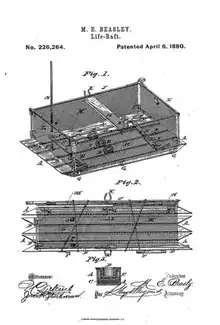Maria Beasley
Maria E. Beasley (née Kenny; 1847-1904)[1] was an entrepreneur and inventor. She is best known for her barrel-making machines and her improvements to the life raft, and she held fifteen different patents in the United States and two in Great Britain.[2]
Maria Beasley | |
|---|---|
| Born | Maria Kenny 1847 |
| Died | 1904 (aged 56–57) |
| Occupation | entrepreneur, inventor |
| Known for | barrel-making machines and improvements to the life raft |
| Spouse(s) | Samuel Beasley |

Biography
Personal life
Beasley was born Maria Kenny in 1847. Little is known of her upbringing or education. It is unclear how she was inspired to become an inventor, though some speculate that she was influenced by the Centennial Exhibition (and specifically the Women’s Pavilion) in 1876. She was married to Samuel Beasley in 1865,[2] and ran the household in addition to her business and creative pursuits. Philadelphia directories from 1880-1890 (with one break in 1887) list her as a dressmaker,[2] despite her filing several patents and developing a barrel-making business during that time. Between 1891 and 1896, Chicago directories listed her occupation as inventor.[2] Beasley died in 1904.
Inventions
Beasley's first patent was granted in 1878.[1] She then had invented a barrel-hooping machine, which she showed at the World Industrial and Cotton Exposition in 1884.[1] Beasley's barrel-hooping machine was designed to speed up the manufacturing of barrels, enabling 1,500 to be produced a day. Beasley's barrel-hooping machine made her quite a lot of money, with the Evening Star writing in 1889, that she "made a small fortune out of a machine for the manufacture of barrels."[3] Her invention could make 1,500 barrels a day.[4] Beasley's other inventions included foot warmers, cooking pans, anti-derailment devices for trains[5] and two improved life raft designs, which were also patented in Britain.[1]
Barrel-Making Machines
Beginning in 1878, Maria Beasley received a series of eight patents for the barrel-making process.[2] These included six mechanical patents, including two simply labeled barrel-making machines, two for hoop-driving, one for barrel setup, and one for barrel-stave shaping. She displayed a barrel-making machine at the World’s Industrial and Cotton Centennial Exposition in New Orleans in 1884. Her inventions attracted sugar and oil refineries, and royalties from contracts involving the use of her barrel-hooping machine alone amounted to $20,000 annually. Some accounts also suggest that she ran a business of manufacturing barrels herself, in addition to the contracts she had with sugar and oil companies.[2]
Life raft design
After her success in the barrel-making industry, Beasley sought to create a better life raft that was "fire-proof, compact, safe and readily launched.” She invented this new design in 1880. Her new design included guard railings surrounding the raft and rectangular metal floats. This design is able to fold and unfold so it is easy to store, even with the rails. Prior to Beasley’s design, life rafts were typically flat, wooden boards. The concepts of guard rails and reduced size for storage remain in use today, although her exact designs have been long outdated.
References
Citations
- Stanley 1995, p. 348.
- Khan, B. Zorina (2005). The Democratization of Invention: Patents and Copyrights in American Economic Development, 1790-1920. Cambridge: Cambridge University Press. p. 153. ISBN 9780521811354.
- "Women as Inventors". Evening Star. 9 November 1889. Retrieved 8 May 2017 – via Newspapers.com.
- "Busy Women". Arkansas Democrat. 14 September 1901. Retrieved 8 May 2017 – via Newspapers.com.
- Jones, Jared (9 March 2016). "Celebrate Women's History Month with 12 awesome things invented by women". Upworthy. Retrieved 2017-05-08.
Sources
- Stanley, Autumn (1995). Mothers and Daughters of Invention: Notes for a Revised History of Technology. New Brunswick, New Jersey: Rutgers University Press. ISBN 0813521971.